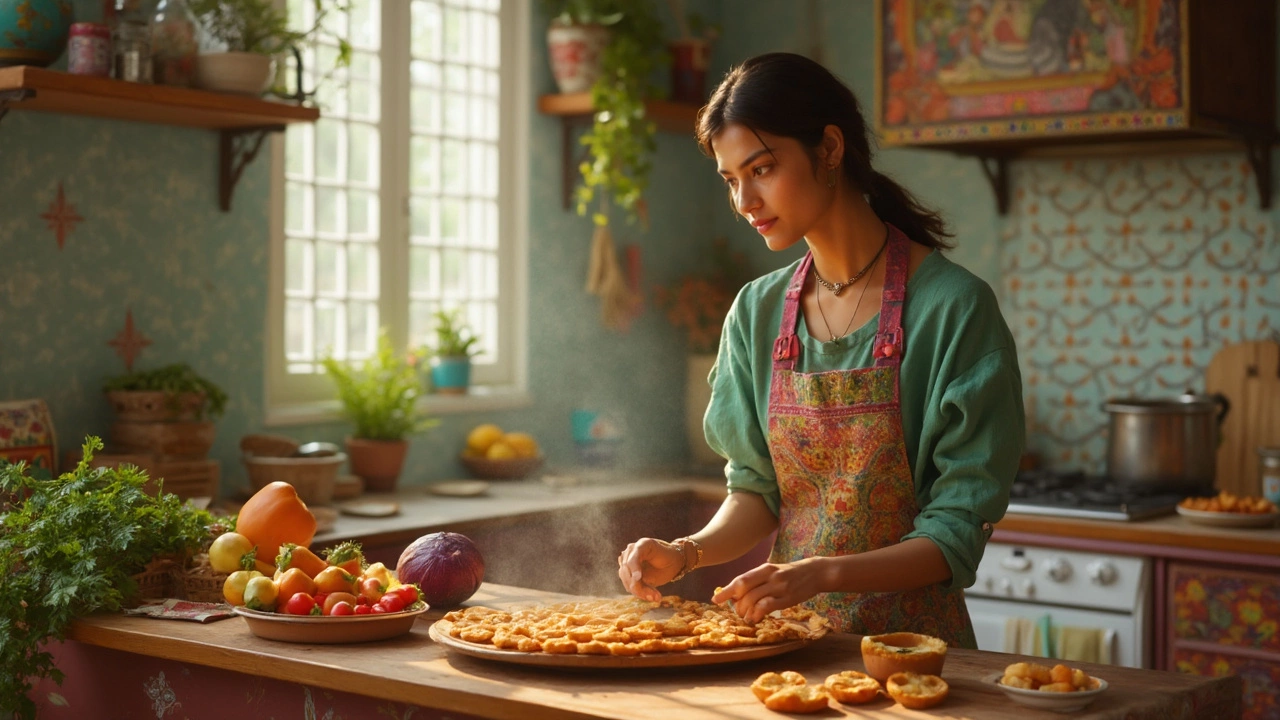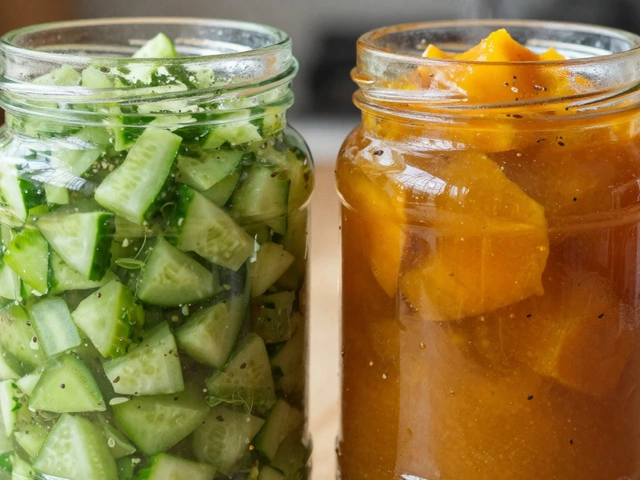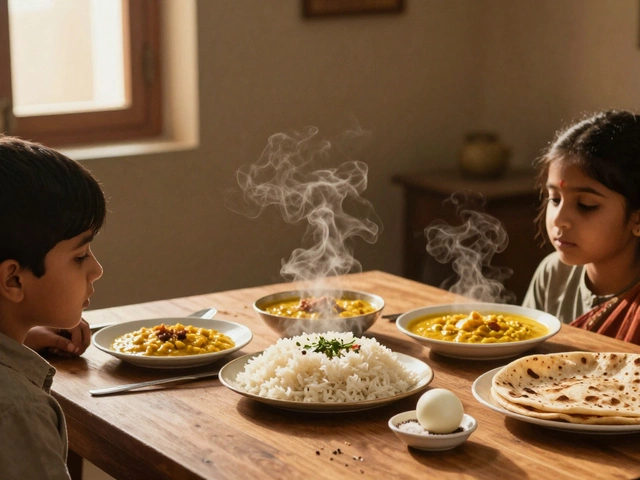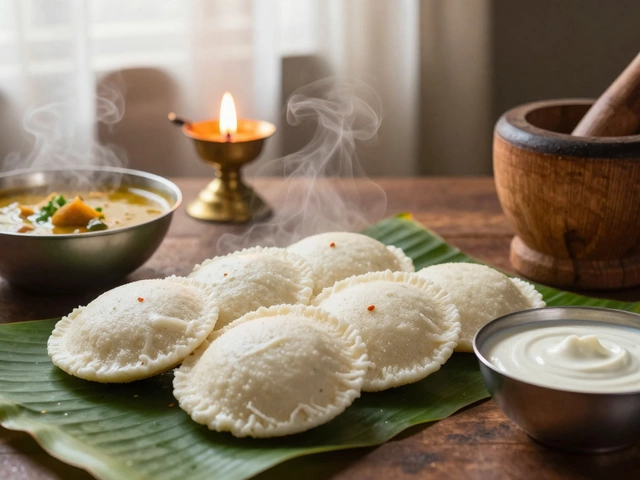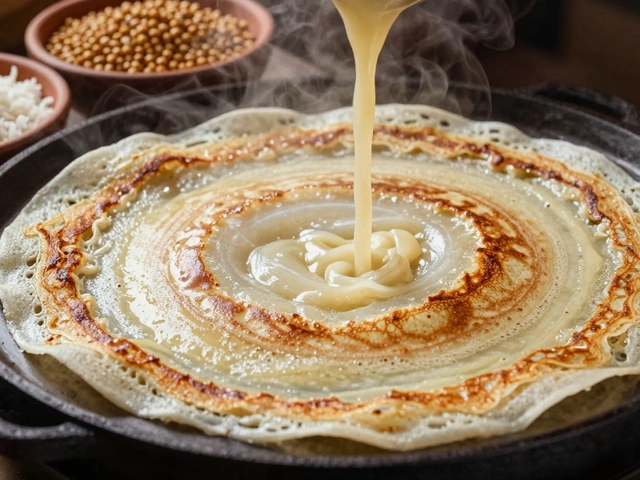Craving something crunchy and spicy and just a little bit naughty? Trust me, I get it. The thing is, not all junk food has to be bad for you—especially if you play your cards right with Indian snacks. Some of the best 'junk foods' from India can actually sneak in a fair bit of protein, fiber, and those good-for-you spices.
Let’s be real, nobody is asking you to quit samosas, bhel, or pakoras forever. The secret? A few smart tweaks and knowing which ones are already surprisingly not-that-bad. I’ve seen my own kid Jasper happily snacking on stuff that I know isn’t going to send his sugar levels sky-high or leave him hungry in an hour.
If you ever wondered,
- What Even Makes Junk Food 'Healthy'?
- Classic Indian Snacks That Aren't a Total Disaster
- Tasty Upgrades: Making Street Food Healthier
- Quick Tips for Smart Snacking
- Can You Really Eat Junk Food Every Day?
What Even Makes Junk Food 'Healthy'?
The idea of healthiest junk food sounds weird, right? But honestly, there’s some real logic behind it. Junk food gets its bad rep mainly because it’s loaded with processed carbs, excess oil, sugar, and very little nutrition. That’s not great for your gut, blood sugar, or energy levels. But what if you flip the script a little?
For a snack to count as "healthy junk food," it needs to bring more than just empty calories. Here’s what sets these snacks apart:
- Fiber: Foods with more whole grains, lentils, or vegetables keep you fuller longer and help digestion.
- Protein: Snacks with chickpeas, sprouts, paneer, or peanuts give you lasting energy and don’t spike sugar as much.
- Lower Oil Content: Baked, grilled, or air-fried versions cut down on heavy fats but keep the crunch.
- Spices and Herbs: Stuff like turmeric, cumin, coriander, and ginger do loads more than just add flavor—they’ve been shown to cut inflammation and help metabolism.
- Less Added Sugar and Salt: Real flavor, not just salt bombs or sugar highs, makes for smarter snacking.
Let’s size this up with a quick numbers check so you know what to look for:
| Snack | Calories (per serving) | Fiber (g) | Protein (g) | Added Oil (g) |
|---|---|---|---|---|
| Deep-fried Samosa | 120 | 1 | 2 | 7 |
| Baked Samosa | 90 | 2 | 3 | 2 |
| Sprouts Chaat | 80 | 3 | 5 | 0.5 |
| Bhelpuri (No Sev) | 70 | 2 | 2 | 1.5 |
So, swapping a fried samosa with a baked or air-fried one, or picking chaat loaded with sprouts and veggies, isn’t just a “diet thing”—it’s way better for energy and hunger. Basically, good healthy junk food gives you crunch and flavor plus something useful for your body. It’s all about the trade-offs and tiny upgrades.
Classic Indian Snacks That Aren't a Total Disaster
You don’t have to avoid every crunchy snack if you’re trying to be a little healthier. Some of the most popular Indian snacks are way better for you than a bag of chips or a pack of cookies, especially if you choose (or make) them the right way. Let’s look at how a few favorites stack up—nutritionally and taste-wise.
- Bhel Puri: This street food legend is basically puffed rice (which is super low in calories), veggies like onions and tomatoes, tangy chutneys, and sometimes peanuts. The fiber from the veggies and the crunch from the puffed rice keep you full, while the chutneys punch up the flavor. Skip the extra sev or deep-fried papdis to keep it light.
- Dhokla: Steamed, not fried—this makes dhokla a sneaky superstar. Made from fermented chickpea batter, it’s not just tasty; it’s got protein, and fermented foods are good for your gut. A single piece (about 40g) can have as little as 80 calories and packs in about 2 grams of protein.
- Roasted Chana: These crunchy little guys are basically Indian trail mix. Loaded with protein and fiber, they help curb cravings and are super portable. A 30g handful has roughly 120 calories, 5g protein, and barely any sugar.
- Idli: Another steamed classic, idlis are made from rice and urad dal. Unlike a fried samosa, two small idlis with chutney make a filling snack without blowing up your calorie count (about 70 calories per idli).
- Corn Chaat: Sweetcorn roasted with lime, spices, and maybe some tomato and onion is much better than buttery popcorn. You get fiber, vitamin C, and tasty crunch with way less oil.
To make it easier, here’s a quick look at how these snacks compare on key nutrition points per typical serving size (approximate values):
| Snack | Calories | Protein (g) | Fiber (g) | Prep Style |
|---|---|---|---|---|
| Bhel Puri | 130 | 3 | 2 | Assembled, not fried |
| Dhokla | 80 | 2 | 1 | Steamed |
| Roasted Chana | 120 | 5 | 4 | Dry Roasted |
| Idli | 70 | 2 | 1 | Steamed |
| Corn Chaat | 100 | 3 | 2 | Boiled, seasoned |
Bottom line: If you crave that snack fix, these options won’t wreck your diet. Just watch the extras like extra oils and fried toppings—it’s those little add-ons that can turn a snack from “not bad” to “oops, too much.” Most of the time, if you stick with steamed, roasted, or build-your-own styles, you’re already winning the healthy junk food game—and, yes, your healthiest junk food hunt is actually doable with these choices.

Tasty Upgrades: Making Street Food Healthier
If you've ever stood by a street vendor and wished you could eat more of your favorites with less guilt, you're in good company. The cool part is, upgrading Indian street snacks isn’t impossible—it’s actually pretty easy if you know what to swap. For starters, lots of the stuff that makes street food junky comes down to deep-frying, excess sugar, and heavy oils. Change up just one of these and you’re halfway to making that snack so much better for your body.
The biggest win? Baking instead of frying. Baked samosas or kachoris keep the crunch but ditch most of the fat. Try air frying—my air fryer honestly sees more samosas than French fries these days. Next up, think chutneys: swap out sugary tamarind or too much sev with dahi (yogurt), fresh coriander, or pomegranate seeds. They give you flavor, not just empty calories.
- Make chaat at home and load it up with chickpeas, tomatoes, onions, and a sprinkle of roasted peanuts for protein and fiber.
- Choose dhokla for a light, steamed option—it packs protein and keeps things low on oil.
- Opt for whole wheat or millet flour in your snack recipes instead of refined flour.
Check this out—an easy comparison of classic vs. upgraded versions:
| Snack | Regular Version (per serving) | Upgraded Version (per serving) |
|---|---|---|
| Samosa (fried) | 300 calories 18g fat 2g fiber | 150 calories 5g fat 4g fiber (baked, whole wheat crust) |
| Bhel Puri (with lots of sev) | 250 calories 30g carbs 12g sugar | 180 calories 22g carbs 4g sugar (with more veggies, less sev, homemade chutneys) |
| Pav Bhaji (with buttered white pav) | 400 calories 14g fat 3g fiber | 270 calories 6g fat 6g fiber (whole wheat pav, less butter, more veggies) |
Nutritionist Rujuta Diwekar puts it simply:
“You don’t have to quit your favorite Indian snacks. Just prepare them with local, seasonal ingredients and traditional methods—like steaming, roasting, or baking—so you upgrade their health profile without killing the taste.”
Healthiest junk food options in India exist, but you’ve got to do a little work. These tweaks mean you can still enjoy chaat with your friends or share samosas with your kids and feel good about it. Try swapping out one thing this week and see how much better you feel after snacking!
Quick Tips for Smart Snacking
The real win with healthy Indian snacks is sneaking in flavor and nutrients without feeling like you’re munching on cardboard. It’s all about smart moves. Let’s make this as doable as possible.
- Try roasting or baking instead of deep frying. Love samosas or pakoras? Just pop them in the oven with a brush of oil. You’ll save a ton of calories and your kitchen won’t smell like a fryer for a week.
- Go heavy on beans and lentils. Stuff like moong dal chilla and chana chaat are packed with protein and fiber, keeping you full longer. Protein, after all, is the base of any truly healthiest junk food snack.
- Watch the portion size. A small bowl of bhel is snack; a gigantic mixing bowl is basically a meal (and it adds up quick, calorie-wise). If you’re serving for kids like I do with Jasper, use smaller bowls or cups for easy portion control.
- Pile on the veggies. Add cucumber, tomato, onion, grated carrot, or leafy greens to your snack—literally anything crunchy or colorful works. More fiber, more vitamins, and less room for the not-so-great stuff.
- Make your own chutneys at home. Skip the bottled versions that are loaded with sugar and salt. Just blend mint, coriander, chili, and lemon juice—so much flavor, plus you know exactly what’s inside.
- If you need a salty crunch, go for roasted makhana (fox nuts) or chickpeas. They taste like chips but come with protein and iron. Jasper actually thinks makhana are ‘magic popcorn’.
Bottom line: You can totally keep your Indian snack traditions going. Just swap out a few basics, amp up the real ingredients, and you get your flavor fix without blowing up your nutrition goals.
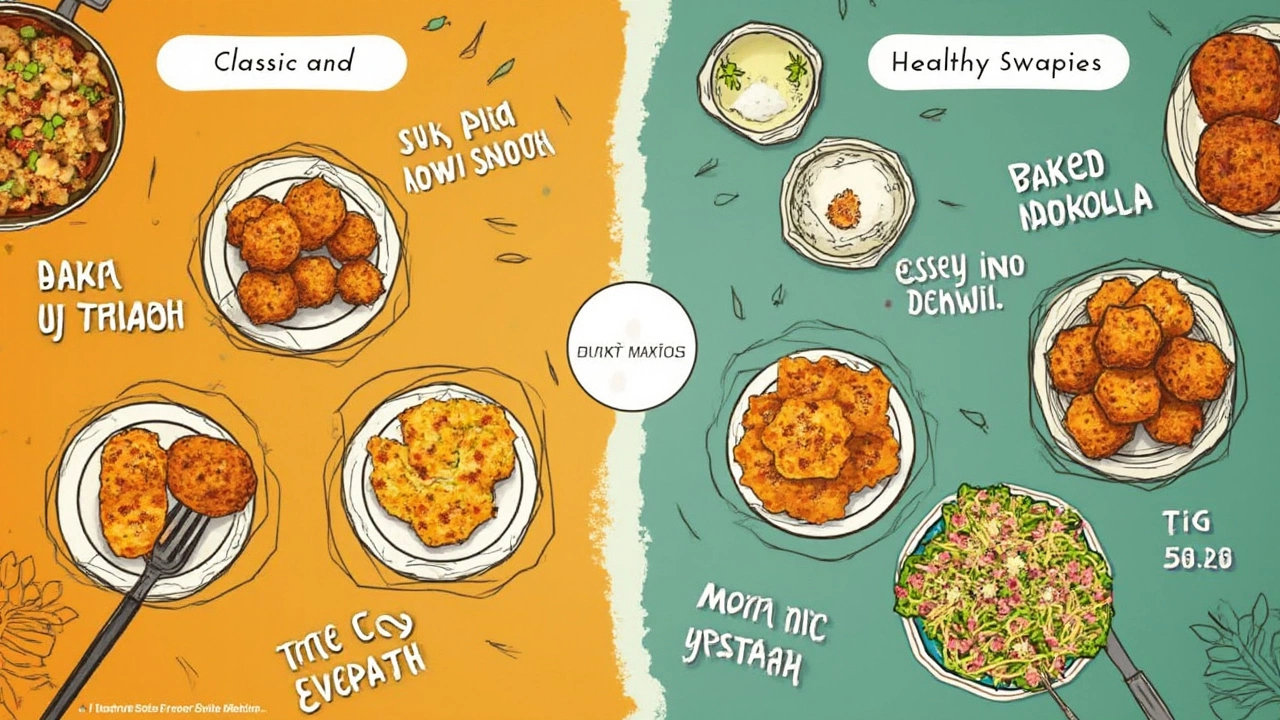
Can You Really Eat Junk Food Every Day?
Okay, so here’s the truth—eating junk food every single day depends on what you mean by 'junk food.' Most of us picture deep-fried samosas or mountains of sugary jalebi. But a lot of Indian snacks can be pretty harmless, especially if you make smart choices, bake instead of fry, and keep an eye on your portion size.
According to the National Institute of Nutrition, “Healthy snacks can fit into a balanced diet when eaten in moderation and prepared using nutritious ingredients.”
“The issue isn’t with snacking itself, but in the choices we make and how often we indulge in high-calorie, low-nutrient foods.” — Dr. Neha Gupta, Nutritionist, New Delhi
If you want to slide in some healthy Indian snacks every day, go for snacks that actually give you something back—fiber, good fats, protein. Here’s what you want to keep on your radar:
- Swap fried for baked or grilled (think baked samosas or roasted chana).
- Choose whole ingredients: chaat made with sprouted moong or whole grain poha is always better than the regular deep-fried stuff.
- Add some veggies (bhel loaded with raw onions, tomatoes, and coriander isn’t just tasty—it’s actually useful for your body).
- Scale down the salt, sugar, and oil—sometimes half still tastes just as good.
Let’s geek out for a second at how these swaps stack up:
| Snack | Calories (per serving) | Protein (g) | Fiber (g) | Frying or Baking? |
|---|---|---|---|---|
| Baked Samosa | 110 | 3 | 2 | Baked |
| Deep-Fried Samosa | 260 | 3 | 2 | Fried |
| Roasted Chana | 120 | 7 | 5 | Roasted |
| Bhel Puri (homemade, less sev) | 150 | 4 | 3 | Mixed/No Fry |
So yes, you can eat 'junk food' every day if you redefine what counts as junk. Go for small sizes, play with recipes, and pick snacks that don’t just taste good, but actually do something useful for your body. And if you fall for the classic vada pav now and then, no big deal—just don’t let it be the only thing you’re eating. Your future self will thank you.
